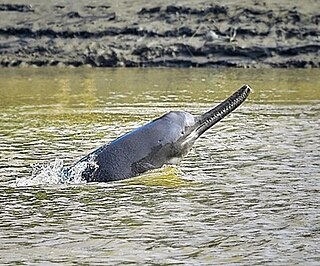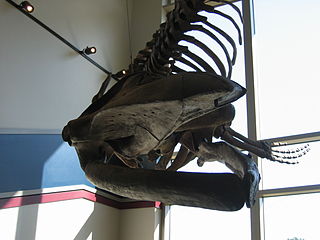Virus classification is the process of naming viruses and placing them into a taxonomic system similar to the classification systems used for cellular organisms.

South Asian river dolphins are toothed whales in the genus Platanista, which inhabit the waterways of the Indian subcontinent. They were historically considered to be one species with the Ganges river dolphin and the Indus river dolphin being subspecies. Genetic and morphological evidence led to their being described as separate species in 2021. The Ganges and Indus river dolphins are estimated to have diverged 550,000 years ago. They are the only living members of the family Platanistidae and the superfamily Platanistoidea. Fossils of ancient relatives date to the late Oligocene.

Orcinus is a genus of Delphinidae, the family of carnivorous marine mammals known as dolphins. It includes the largest delphinid species, Orcinus orca, known as the orca or killer whale. Two extinct species are recognised, Orcinus paleorca and O. citoniensis, describing fossilised remains of the genus. The other extinct species O. meyeri is disputed.

Eobalaenoptera is an extinct genus of baleen whale belonging to Balaenopteroidea.

Incertae sedis or problematica is a term used for a taxonomic group where its broader relationships are unknown or undefined. Alternatively, such groups are frequently referred to as "enigmatic taxa". In the system of open nomenclature, uncertainty at specific taxonomic levels is indicated by incertae familiae, incerti subordinis, incerti ordinis and similar terms.

Ensifera is a suborder of insects that includes the various types of crickets and their allies including: true crickets, camel crickets, bush crickets or katydids, grigs, weta and Cooloola monsters. This and the suborder Caelifera make up the order Orthoptera. Ensifera is believed to be a more ancient group than Caelifera, with its origins in the Carboniferous period, the split having occurred at the end of the Permian period. Unlike the Caelifera, the Ensifera contain numerous members that are partially carnivorous, feeding on other insects, as well as plants.
Agustinia is a genus of sauropod dinosaur from the Early Cretaceous of South America. The genus contains a single species, A. ligabuei, known from a single specimen that was recovered from the Lohan Cura Formation of Neuquén Province in Argentina. It lived about 116–108 million years ago, in the Aptian–Albian stages of the Early Cretaceous Period.

Prosqualodon is an extinct genus of Early to Middle Miocene cetacean from Argentina, Australia, New Zealand and Venezuela.

Carnivoramorpha is a clade of placental mammals of clade Pan-Carnivora from mirorder Ferae, that includes the modern order Carnivora and its extinct stem-relatives.

Delphinoidea is the largest group of toothed whales, including 66 genera in 6 families. The largest living member of the superfamily is the killer whale, which can reach 6 tons, while the smallest is the vaquita.

Waipatiidae is an extinct family of odontocetes currently known from the Oligocene of the Pacific Ocean and possibly Europe and the Caucasus.
Pontogeneus is a genus of extinct cetacean known from fossils recovered from the Late Eocene sediments of the southeastern United States.
Peripolocetus is a genus of balaenid baleen whale from the middle Miocene of Kern County, California.
Pontobasileus is an archaeocete whale known from a fragment of a single tooth described by Leidy 1873. It can questionably be dated to the Eocene of Alabama.
Cardiosyne is an extinct genus of beetles from the Triassic of Argentina. It was originally tentatively classified in Elateridae, but in 2020 it was transferred to Coleoptera incertae sedis.
Squaloziphius is an extinct genus of odontocete cetacean from the Early Miocene (Aquitanian) aged marine deposits in Washington state.

Mirocetus is a genus of archaic odontocete from the late Oligocene (Chattian) of Azerbaijan. Like many other primitive odontocetes, its classification has been fluid since its description.
Xenorophus is a genus of primitive odontocete from late Oligocene (Chattian) marine deposits in South Carolina. It belongs to the Xenorophidae.
Algospongia is a class of small, calcified fossil organisms of uncertain taxonomic position, assigned in a comprehensive 2010 review to "Animalia" incertae sedis, but both prior to and post that to an unnamed phylum of Algae; other workers simply list them as Problematica. They occur in carbonate rocks of the Paleozoic era and their last representatives occur in the Late Permian geological period. Characteristic genera include Aoujgalia, Moravammina and the early-appearing Wetheredella, although the taxonomic validity of the last named genus has been disputed.









